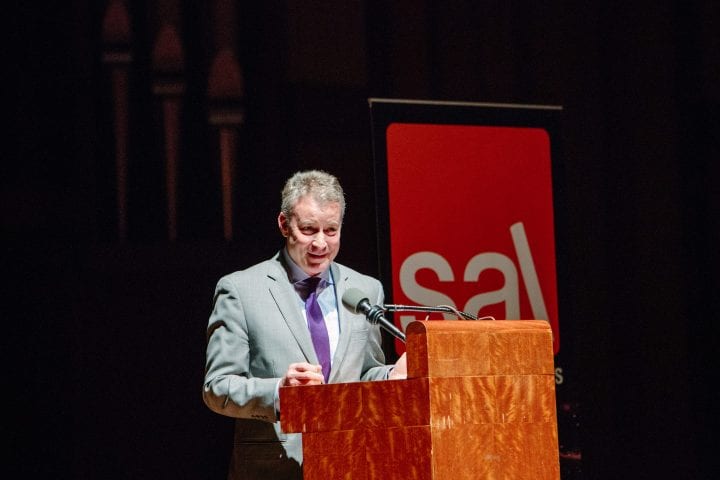
Introductions: Timothy Egan
November 3, 2016
On October 26 at Benaroya Hall, National Book Award-winning author and journalist Timothy Egan joined us for a night of time travel, discussing the research process and emotional journey he takes when bringing his American portraits to life. SAL Associate Director Rebecca Hoogs introduced Tim for this event, the second evening in SAL’s 2016/17 Literary Arts Series.
By Rebecca Hoogs, SAL Associate Director
It is a great pleasure to welcome hometown hero, the historian and journalist Timothy Egan to the series. Born and raised in Seattle, Timothy Egan comes from a large family of 9 children. And, with the publication of his most recent book last year, The Immortal Irishman: The Irish Revolutionary Who Became An American Hero, he is now the father of a large and growing family of 9 books. Like children, each book is unique, clearly deeply loved, and reveals a bit of the literary DNA of the writer behind them.
His books have ranged from our Pacific Northwest landscape and its ever-present rain (exhibit: today), to a Spokane real-life crime story, to his National Book Award winning volume, The Worst Hard Time, on the dust bowl and those who very literally weathered it. His work has taken on fire and our natural lands in The Big Burn, and gave us a masterful portrait of the portrait-master Edward Curtis in the biography Short Nights of the Shadow Catcher. “When it comes to this spectacularly mildewed corner of the American linoleum,” Tom Robbins has said, “Timothy Egan gets it right.”
In addition to his books, Timothy Egan got it right for 18 years as a writer for the New York Times, first as the Pacific Northwest correspondent, then as a national enterprise reporter where he the won the Pulitzer Prize as part of a team of reporters who wrote the series “How Race Is Lived in America.” He is now a columnist there, where he has been most recently mapping the terrible topography, the ups and downs and further downs, the rain and firestorm, of the current election cycle.
Of Lasso the Wind, an early book in the Egan family, a reviewer wrote that “Egan has produced a moving study of the West: how it became what it is, and where it is going.” And this has proved true of all of his impeccably researched and lovingly crafted prose: no matter the subject, he has helped us to understand how we became who we are—as Seattlites, as inhabitants of the West, as we the people of the United States of America—and where we’re going. Perhaps more than anyone else, he is our dispatch from the West, the voice reminding the rest of the country that we’re out here, and the voice reminding us to look inward at our constantly revising histories.
His big family of books and writing has invited us in, asked us to sit down at the table, and compelled us to think as big as a Montana sky. We couldn’t be more grateful for his writing, or more proud to call him our own. Please join me in welcoming Timothy Egan.